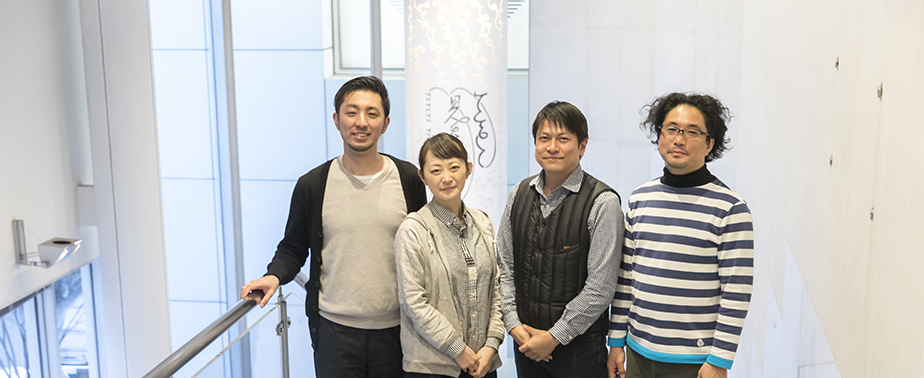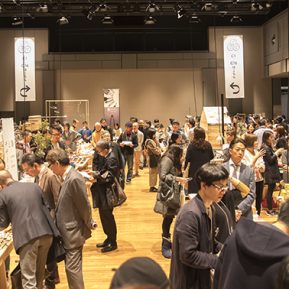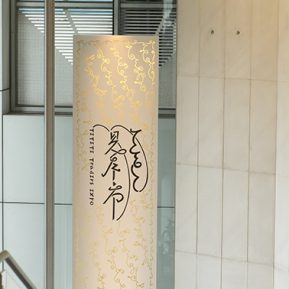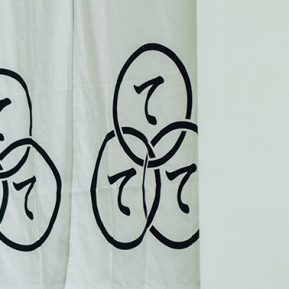
TE TE TE Consortium co-representatives Takuya Matsuo (left) and Yukiko Yoshikawa (right)
– Changing the world from a minority position
–I thought the sight of exhibitors exchanging information not only with buyers but also with neighboring exhibitors was very characteristic of the TE TE TE Traders Expo. It felt like a gathering of like-minded individuals rather than a place for business deals.
Matsuo That’s what we’ve always aimed for with TE TE TE. I don’t think there are any other exhibitions like this. Those of us in the operations team originally started TE TE TE because we wanted to have plenty of time to talk to the exhibitors, after all.
Yoshikawa With so many other exhibitions already out there, if we just wanted to provide a place to do business there wouldn’t be any point to us continuing to hold this trade fair. We’ve tried to create an opportunity for exhibitors to interact with each other and for visitors to interact with each other amid the same value system. Like a collective or a community.
Matsuo Or an ecosystem.

Spiral Hall, the event’s venue. Exhibitors’ booths line the event hall.
–The event has moved from TOLOT/heuristic SHINONOME (Shinonome, Koto City) where it was held up until last year to Spiral Hall (Aoyama, Minato City) this year. What are the attendance numbers and trends like?
Matsuo We’ve seen a big increase in attendees, and I think we’re seeing buyers from a wider range of industries as well. It’s a more convenient location, which is a factor, but I’m also thinking that this is our sixth TE TE TE show, and word is spreading about our philosophy. I’m an optimist like that (laughs).
Yoshikawa We’ve been surprised by the duration of the attendees’ visits. Some buyers are at the venue from morning till late afternoon, putting in a very solid day.

With 100 exhibitors from all over Japan this year, conversations and business discussions took place as many buyers visited in search of new products.
–You even ran out of attendee card holders around noon on the second day.
Matsuo We didn’t expect so many of our visitors to come in first thing in the afternoon. The surge might have something to do with the Aoyama location. We were lucky to be able to get through it with minimal confusion. As far as operations go, we’ll have to find the best methods through actual practice.
Yoshikawa This was also an opportunity to see how things go with 100 exhibitors in this venue. All of our exhibitors are aiming for appropriate volumes in operating their businesses, so we need to take the same approach on the operations side of TE TE TE as well. Based on the results of this year’s event, scaling down next year is one of the options.
Matsuo The question is whether we can continue with this scale and this venue. The number of attendees isn’t the only absolute benchmark.
Yoshikawa But you never really know until the doors open. I’m always worried that maybe nobody will come this time until the venue opens on the first day.
Matsuo Many of the buyers were very interested in the background behind the creative process, and the exhibitors were very happy about that. But it took us five years to get this far. It feels like our ideals are finally being realized with our sixth show.
–What kinds of problems did you have when you were starting out with TE TE TE?
Yoshikawa We had 20 exhibitors for our first event. All of the exhibitors and visitors were people we knew, so we didn’t need to worry about shared values. That only became a problem when the scale grew, for the third event and after.
Matsuo When we transitioned from jointly hosting the event with EXTRA PREVIEW (for the first through third events) to a standalone show, we spent a lot of time thinking about how to ensure the medium-scale production and handicraft themes really got through.
Yoshikawa At the operations team meetings, we were always asking ourselves what kinds of people we wanted to exhibit at the event. We were all flipping through phone books working hard to look for creators we wanted to meet.

Food booths also line the show floor. Left: Enoura Nori Honpo from Fukuoka. Right: the Japanese herbal tea brand {tabel}.
–There are many exhibitions that specialize in one industry, like food or architecture, but exhibitors from many industries gather at TE TE TE. Many of them told me they decided to exhibit here because they identified with TE TE TE’s approach of presenting the way everyday life can be.
Yoshikawa It’s a great feeling when someone chooses TE TE TE based on our values. I don’t think we’re making a change for society as a whole yet, though. We’re still niche, I think. You’re always saying you don’t want us to be mainstream, right, Matsuo-san?
Matsuo Right. We take pride in being the minority. I want to make a difference little by little from that position.
–What trends do you see with buyers from overseas?
Matsuo I got the impression that we had a lot of buyers from China last year, but I don’t see as many this year. I’m seeing a good mix of countries and regions. I have day-to-day business relationships with about 200 stores in 35 countries. Even if I didn’t send them invitations to the event, some of them heard about it from somewhere and came to Tokyo—it’s like our shared values are bringing us together. That said, they don’t buy a product just because it’s made in Japan or made with traditional Japanese techniques. There is demand for things with functionality and beauty that can blend seamlessly with life in each country or region, and convey Japanese culture on top of that.

Banners and handouts were produced based on this year’s main visual.
–What challenges does TE TE TE Traders Expo face?
Matsuo Right now, I want words. There really isn’t a way to explain the TE TE TE philosophy in a succinct way to people outside Japan. We’ve created new words in Japanese for “medium-scale production” and “handicrafts.” We’ve been looking for the perfect words for these in English, but haven’t found them yet. It’s frustrating to have to depend on long-winded explanations to try to convey TE TE TE’s philosophy and ideals when I’m overseas. The English words “medium-scale production” and “handicrafts” are close, but they’re still a little off.
Yoshikawa That’s our objective moving forward. No, our ambition.
Matsuo It would be awesome if I could just say “TE TE TE” and everyone all over the world understood what I was talking out.

Matsuo and Yoshikawa discuss TE TE TE’s activities and future.
–Mr. Oji and Mr. Nagata mentioned that they were interested in taking on projects other than the traders expo with the current team, but what do you think about diversifying and expanding?
Yoshikawa There are a lot of different ideas, so I’d like to think about them along with the best timing to take them on. Sitting and waiting for offers to come in doesn’t suit us. Like the traders expo, projects we start because we see a need for them are the most meaningful, and most suitable for TE TE TE.
Matsuo I want to do something that has a sense of inevitability for us. And I want to believe that it’s something that society wants, too. Now that TE TE TE is a company, I want to think about the best way to leverage the experience we’ve built up so far.
Takuya Matsuo
Representative partner and distributor at FOUR DESIGN LLC. Born in Tokyo in 1970. Graduated with a B.S. from the University of San Francisco in California in 1994. After working at Terumo Corporation, InfoCom Research, Inc., and NTT Data Corporation, he launched FOUR DESIGN LLC as a distributor of handicraft and medium-scale production products in 2010. Using his hands-on experience with international communication and global business, he assists handicraft manufacturers and creators looking to expand overseas and globally with distribution and sales strategies.
Yukiko Yoshikawa
Design manager. Born in 1978. Grew up in Kanagawa Prefecture. After graduating from Musashino Art University, she worked at a housing manufacturer, design agency, and interior furnishings shop before establishing SHUHENKA in 2014. Using her experience with both creation and communication, she works in planning and operation for various design efforts to connect design with local regions.
– After the interview
There are likely very few trade shows where you see a group of 150 people raising their glasses together in a toast on the first night of the event. Every year, most of the exhibitors are said to attend the customary social event for the TE TE TE Traders Expo. It is no simple party—exhibitors discuss their current situations, ways to improve the creative process, and their troubles and concerns. At times, collaborations result from these discussions. In the words of Okisato Nagata of the TE TE TE Consortium, it’s “TE TE TE Part Two.” This feeling of solidarity is the strength of TE TE TE Traders Expo, enabling it to act as the path to greater exposure and success for handicrafts from many regions. During the interview, the sight of multiple exhibitors discussing ideas and ideals with buyers was a common one throughout the venue. This was striking because these were not one-on-one business discussions, but groups of three to five people forming spontaneously in a way that transcends the standard notion of trade shows.
The four members of the TE TE TE Consortium each use different words to express this unique aspect of TE TE TE—”fellowship” (Oji), “community” (Nagata), “ecosystem” (Matsuo), and “collective” (Yoshikawa). Because they are breaking new ground, it seems that no one’s word is sufficient to describe their philosophy. As they reach their sixth year, Matsuo’s statement that he wants to “create words that can help anyone understand the idea in just a few words” is likely because he feels firsthand that those words are necessary for them to reach the next stage.
After getting started in 2011 with only 20 exhibitors, the handmade trade show has grown to attract 100 exhibitors from all over Japan, from Hokkaido to Okinawa, just six years later. We hope to continue to follow the efforts of the TE TE TE Traders Expo community to bring a new culture based on the values of medium-scale production and handicrafts to the production and distribution of handmade products.

From left: Okisato Nagata, Yukiko Yoshikawa, Masanori Oji, Takuya Matsuo. These four are at the center of operations for the TE TE TE Consortium.
TE TE TE Consortium
http://tetete.jp/
https://www.facebook.com/tetetecommittee
SPECIAL
TEXT BY YUJI YONEHARA
PHOTOGRAPHS BY MITSUYUKI NAKAJIMA
17.03.20 MON 20:31




